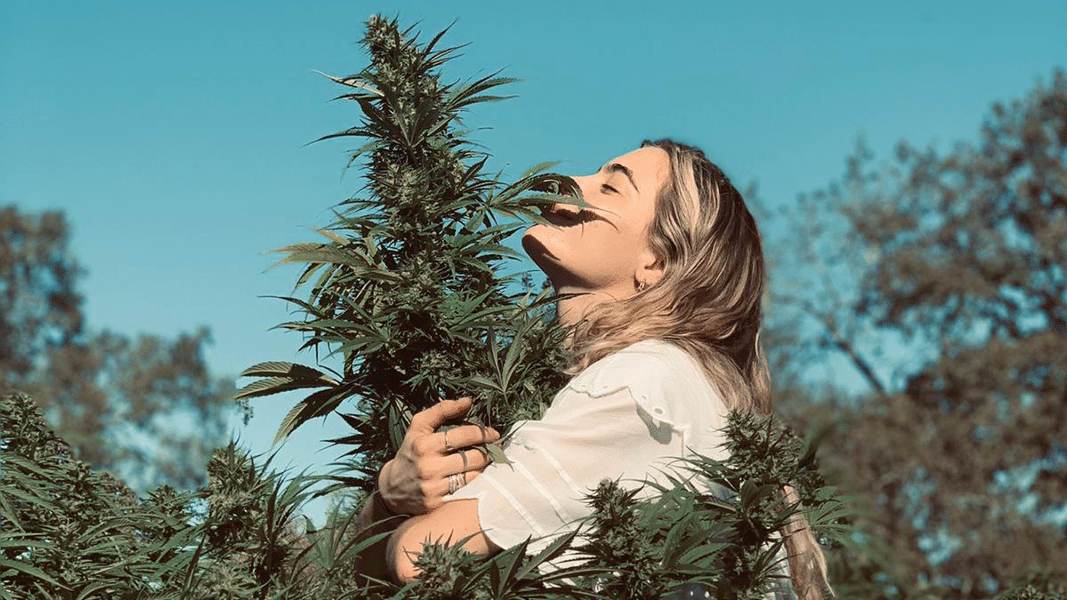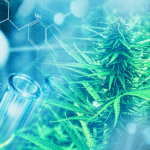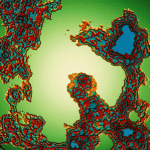At night you might find Chelsea Leyland, a 31-year-old British celebrity DJ, juggling beats at a flashy Miami party while rocking a Simone Rocha dress that complements her honey-hued hair and brown eyes. By day she shifts into activist mode, traveling the country, giving interviews, talking at conferences and filming a documentary — all on the complex and controversial subject of medical marijuana. Leyland wants people to know how she has overcome a crippling neurological illness. She is epileptic, and she’s been seizure-free for several years without using any pharmaceuticals. Her only medicine is cannabis.
Leyland remembers the day her epilepsy rudely announced itself. She was 15, sitting in the backseat of the family car. They were driving in the London suburbs through a grove of trees, and the dappled sunlight flickered through the leaves, triggering strange sensations in her head. “My brain felt funny,” she says. “It was like it went on a different frequency.”
Over time, this “funny” feeling in her brain evolved into episodes of sudden jerking movements in her limbs, often in the morning while Leyland would be eating breakfast, and her cereal bowl or tea cup would drop from her hand. (Doctors refer to it as “flying saucer epilepsy,” when sufferers inadvertently fling dishes around during a seizure.) Leyland was eventually diagnosed with juvenile myoclonic epilepsy, a type that typically begins in adolescence. She was prescribed anti-epileptic medications whose side effects included anxiety, irritability, rage and depression. But the seizures continued.
“Everything Suddenly Feels Unreal”
Epileptics have likened the moments leading up to a seizure as “a cold wind blowing from my feet to my head … everything suddenly seems unreal.” An episode might begin with a neuronal misfiring in the brain that triggers an explosive chain reaction of excitation and a cascade of aberrant symptoms: visual and auditory disturbances, weird flavors and odors, pupils dilate, muscles stiffen and jerk uncontrollably. An epileptic may vomit, cry out, fall down and lose consciousness, waking only after the episode is over, remembering nothing.
When thinking of epilepsy, one is apt to picture a person lying on the ground and shaking violently, foaming at the mouth, eyes rolled back in their head. Such generalized grand mal or “tonic-clonic” seizures are but one of epilepsy’s myriad manifestations, many of which are not obvious to others. This hidden side of epilepsy often makes it especially hard to treat – the flashbacks, mood swings, disjointed feelings of déjà vu, difficulty concentrating, memory lapses, and other cognitive impairments.
The aftermath of an epileptic episode often leaves one exhausted for days, with insomnia, pain and brain fog. “I just felt totally stupid,” says Leyland of a typical post-seizure bad day. “I couldn’t find the right words, couldn’t think straight. I couldn’t just suck it up. It affected my work and personal life.”
Depression is common among epileptics, as are psychological disorders such as panic attacks and agoraphobia. There’s also the festering anxiety. The stress of knowing that a seizure could happen at any time can cause constant fear and avoidance behaviors that are confusing to other people. “They thought I was acting like an over-sensitive, precious princess,” says Leyland, who often canceled plans or felt trepidation in new situations. “They didn’t know how relentlessly epilepsy can control one’s choices, how security becomes paramount.”
Always ‘On’
John De Villa understands all too well the overwhelming anxiety that comes with epilepsy. Like Leyland, his first seizure occurred while he was driving, and to this day he still feels anxious whenever he gets behind the wheel of a car. De Villa, then 40, was ushered into the epileptic hall of horrors on July 1, 2015, when he suddenly felt “funny” and noticed a strange taste in his mouth. His wife Maxine and his two Shih Tzu dogs, Prince and Kobe, were riding with him. He pulled over to the shoulder and proceeded to have a grand mal seizure. It felt like “my brain just catapulted out of my body,” De Villa explained.
Up until that day, De Villa, a Canadian with a shaved head and easy smile, had nary a health issue. In an instant everything changed. Now he was bedridden, unable to walk to the bathroom or pour himself a drink of water. He couldn’t even form a full sentence. Maxine was terrified. Even the canine couple knew something was wrong. Prince and Kobe vigilantly stood sentry by De Villa’s bedside, licking his face whenever he seized.
Yet dozens of medical tests revealed nothing abnormal. The doctors were stumped until a neurologist asked De Villa about his occupation. A former anti-hacking security guard at an IT firm, De Villa had worked an extremely stressful job. “For years I rarely slept for more than three hours at a time,” he says. “I was always ‘on’.”
The neurologist had seen similar cases where years of intense work wreaked such havoc on the brain that it was enough to kindle a seizure disorder. So, they put De Villa on a dozen different anti-epileptic drugs. These prescription pharmaceuticals, which included highly addictive benzodiazepines, reduced the number of seizures he experienced, but they also turned him into “a total zombie.” He couldn’t work, he couldn’t drive, he could hardly walk or keep his eyes open. De Villa’s wife was suddenly thrown into the role of full-time caretaker and breadwinner. Sure, her husband was being kept alive by the drugs, but their lives were a mess.
Better Deadened than Dead?
In the not-so-distant past, a person suffering from epilepsy was considered either blessed by a divine force, or cursed by the devil (more often, the latter). The ancient Greeks believed that only the gods could cure this “sacred” disorder. In Medieval Europe, incense-suffused exorcism rituals became the go-to remedy for epileptic contortions, which were seen as a form of demonic possession.
Through the ages, various treatments for epileptic “fits” have been plucked from an occasional-hit-but-mostly-miss parade of mistletoe, lithium, arsenic, turpentine, opium and morphine. Then there was silver nitrate (which turned your skin blue-grey), followed in the mid-1800’s by the discoveries of potassium bromide and phenobarbital. Both of these chemicals were helpful for quelling seizures, but also caused vomiting, staggering, slobbering, rotted the liver, and deadened the senses.
In 19th-century Europe and the United States, epileptics were heavily sedated, confined to their homes, put in restraints, and had parts of their skulls surgically removed. Male epileptics were sometimes even castrated (due to a suspected association of epilepsy with masturbation). Today the most common form of treatment is long-term drug therapy, relying heavily on sedatives.
While potent anti-epileptic drugs (AEDs) have been a lifesaver for many, they are not a cure and they have many downsides. Side effects of AEDs include relentless fatigue, sleepiness, vertigo, nausea, extreme mood swings and weight gain. Long-term use is associated with metabolic changes, liver disease, increased risk of stroke, bone thinning, hormonal irregularities, vision disturbances, kidney stones, decreased platelets and pancreatic problems. That’s what the future looked like for John De Villa and Chelsea Leyland.
“It’s Not Magic”
As a young adult with epilepsy, Leyland rebelled against her anxious, security-obsessed self. She moved to New York City, started a career as a DJ, and threw herself into intense, often scary situations as a way to take a stand against her condition and refuse to let it define her. But the constant stimulation, late nights, and jet lag combined with the heavily sedating effects of the AEDs — were all too much. Trying to craft a normal life while battling epilepsy was taking a major toll.
Leyland struggled to maintain her ambitious career while grappling with her epileptic symptoms and the awful side effects of the medications. Then one day in 2016 at the urging of a friend she tried a hemp-derived CBD extract. She experienced an immediate, positive shift in her health. “I thought, ‘This is what it must be like not to have epilepsy,’” Leyland recalls. “CBD allowed me to feel more normal.”
For several months, she experimented with different CBD-rich products — both hemp-derived and cannabis-derived, full-spectrum as well as isolate – varying the dosages according to what seemed to work best. Leyland used CBD to wean herself off pharmaceutical meds. But after her initial improvement on a CBD regimen, she still struggled with insomnia, fatigue, and cognitive issues, as well as severe pain from endometriosis and irritable bowel syndrome.
Living in New York City, Leyland became a certified medical marijuana patient. In 2018, she went to a state-licensed dispensary in Manhattan and obtained a whole-plant CBD-rich cannabis product that included a healthy percentage of THC. She noticed more pronounced effects right away. “Everything felt sharper,” Leyland told Project CBD. “It was like the missing puzzle piece had fallen into place.”
Chelsea Leyland’s experimentation with varying ratios of CBD and THC paid off. Her sleep improved, so did her gut issues. Her seizures went into remission. With THC in the mix, everything settled into a better groove. These days, Leyland says her health is the best it has been in years.
Popping a pill was never the answer for Leyland, anyway. She prefers a holistic approach. “I have to do the work,” she says. “I stay away from sugar and simple carbs. I exercise, get acupuncture. I use cannabis every day for epilepsy, and it also treats my other conditions. I use extracts, I vape, use topicals and suppositories. It’s not magic. These are real and effective.”
The Promise of CBD
The use of cannabis to treat brain disorders goes back a long way. Ancient Assyrian texts mention cannabis as a cure to ease the “Hand of Ghost,” as epilepsy was then known. Time-travel to 1842: the eminent Irish surgeon William O’Shaughnessy described “gunjah” or “Indian hemp” as “an anti-convulsive remedy of the greatest value.” And in 1860, the Ohio Medical Society included “infantile convulsions” and “epilepsy” among the many indications that respond well to cannabis tinctures. These remedies were widely available in the United States until 1937, when “marihuana” effectively became illegal.
Knowledge of the many therapeutic uses of cannabis soon fell by the wayside, a casualty of reefer madness and federal prohibition. Consigned to the margins for half a century, cannabis would reemerge as an urgent therapeutic option during the AIDS epidemic. The Golden State led the way in 1996 when it legalized the therapeutic use of cannabis. Medical marijuana became a contagiously popular political issue. The fortuitous rediscovery of CBD-rich plants in Northern California in 2009 accentuated a pro-cannabis cultural shift that was already gaining traction throughout the country.
In the summer of 2013, CNN broadcast Sanjay Gupta’s groundbreaking report on CBD-rich hemp oil doing wonders for children with catastrophic seizure disorders in Colorado. CBD became an instant medical rock star. What’s more, CBD was not intoxicating like THC – it didn’t make the kids feel high. The prospect of benefiting therapeutically from cannabis without smoking it or getting high would prove to be irresistible for many people. A legislative stampede ensued as state after state passed “CBD-only” measures that legalized hemp-derived CBD extracts with little or no THC. The FDA would eventually approve Epidiolex as a pharmaceutical CBD isolate for two kinds of pediatric epilepsy.
Gateway to THC
John De Villa had read about CBD-rich cannabis and, desperate for relief, he decided to give it a try. It was 2015 and at the time marijuana was still illegal in Canada, but he managed to obtain a whole-plant, CBD-rich cannabis oil extract on the black market, one that contained no discernible amount of THC. The effects were noticeable almost immediately. He started having fewer seizures. CBD seemed to make his other medication work better, so he needed to take less of what was making him feel so lousy.
After several months of progress, however, De Villa developed a tolerance to cannabidiol, and it stopped working. He tried to press the reset button by taking periodic breaks from CBD, whereupon the seizures returned. But he was determined not to go back on more pharmaceuticals. The re-sensitivity periods were brutal. To fully detox from addictive AEDs, it took eight months of “sweating, shaking, craving, loss of appetite,” says De Villa. “Twice I almost gave up.”
What helped De Villa most of all during his season in rehab hell was when he added some THC to his CBD-rich cannabis regimen. Initially he had been leery of the stigma associated with getting stoned, but De Villa was desperate for anything that might restore the feeling of normalcy that he had initially achieved with CBD. THC proved to be a game-changer. Once he was free of the meds, “it was like the clouds lifted. I finally felt clear and functional again,” he recounted. The seizures stopped, and to date De Villa has not had another epileptic episode. Fortified by his daily CBD–THC intake, he’s been seizure-free for four years and counting, knock on wood.
These days De Villa uses a full-spectrum cannabis extract with a 4:1 CBD-to-THC ratio during daylight hours, and he usually consumes a THC-dominant product at night for sleep. Occasionally, he’ll reach for a raw THCA-rich product, which also appears to have anticonvulsant properties and is nonintoxicating, as well. De Villa’s wife and his immigrant Phillipino parents (both in their 70’s) are also using medical cannabis, which has helped reduce his father’s prostate enlargement so radically that his doctors were shocked. Even Kobe and Prince take a daily dose of CBD-infused dog food.
Staying the Course
Leyland and De Villa both feel profoundly thankful for the relief they’ve gotten from full-spectrum cannabis oil, and they share a desire to help others who are struggling with seizures. De Villa courageously went public with his story before cannabis became legal in Canada, and he continues to offer support and information to epileptic sufferers while running two businesses from home with Maxine and their furry sidekicks, having learned the hard way to keep the stress levels low. Leyland spends much of her time educating people about CBD and medical cannabis.
While traveling, Leyland is able to access various cannabis products in states that have legalized the herb. But she can’t bring any form of cannabis with her when she goes back to London to visit her sister Tamsin, who is also epileptic. Tamsin suffers from a severe neurological disorder that blasts her with as many as 100 seizures daily. She currently lives outside London in a National Health Service facility.
Leyland believes cannabis could help Tamsin, but in Great Britain it’s extremely difficult to get a prescription. Currently, there are only a handful of official medical cannabis patients in the U.K., and government-approved cannabis is very expensive, averaging about $30k per year. Consequently, many patients resort to the black market to get badly-needed medicine at a cheaper price.
“It’s not a question of smuggling a CBD tincture from the U.S.,” says Leyland, who believes that patients should not have to seek cannabis from underground sources. She feels it’s outrageous that ailing individuals have little choice but to experiment with unregulated products, which may or may not have been grown or manufactured properly and may not contain the cannabinoid content or profile they need.
The story of two sisters with epilepsy — one living a vibrant, productive existence and the other with a condition that for now holds little hope for improvement — is at the heart of Leyland’s work. In addition to her non-profit, CBD for Epilepsy, Chelsea is collaborating on a documentary, “Separating the Strains,” which follows the Leyland sisters and aims to present more than just anecdotal accounts of how cannabis has helped people with epilepsy and other neurodegenerative diseases. The film will explore the current science, as well as growing and processing methods, with an emphasis on safety, reliability, and above all, patient access. She hopes the film will help people make informed decisions when using cannabis for health purposes. Her ultimate goal is to change government policy in the U.K., the U.S., and beyond.
“Cannabis has given me back my life,” says Leyland. “It’s gotten me off pharmaceuticals, allowed me to sleep again, to go through my days without the fear hanging over me that I might have a seizure. It’s really the most successful medicine for my situation. And I believe it could help my sister. Once we gain access for her and other sufferers, seizures will decrease and the quality of life will improve.”
Leyland realizes that what works for one epileptic may not work for others. But without legal, safe and affordable access to a range of cannabis remedies – not just CBD – patients like her sister won’t have the chance to find out if they can benefit from cannabis oil. It’s a tragic, life-or-death situation that both Leyland and De Villa have managed to overcome with help from cannabis. Knowing what it means to be haunted by epilepsy, neither will rest until all epileptics have a similar shot at the quality of life they both now enjoy. For these two, that’s something worth fighting for.
Melinda Misuraca is a Project CBD contributing writer with a past life as an old-school cannabis farmer specializing in CBD-rich cultivars. © Copyright, Project CBD. May not be reprinted without permission.
References
- Gowers, W.R. (1881). Epilepsy and other chronic convulsive diseases : their causes, symptoms, & treatment. London: Churchill.
- Temkin, Owes. (1945). The falling sickness : A history of epilepsy from the Greeks to the beginnings of modern neurology. Baltimore: Johns Hopkins Press.
- Hebel. E.L. (2013). Marihuana: The First Twelve Thousand Years. New York: Springer Science & Business Media.
- Russo, E. Cannabis and epilepsy: An ancient treatment returns to the fore. Epilepsy and Behaviour. 2017 May;70(Pt B):292-297. Epub 2016 Dec 15. PubMed PMID: 27989385.
- Lattanzi, Simona & Brigo, Francesco & Cagnetti, Claudia & Trinka, Eugen & Silvestrini, Mauro. (2018). Efficacy and Safety of Adjunctive Cannabidiol in Patients with Lennox–Gastaut Syndrome: A Systematic Review and Meta-Analysis. CNS Drugs. 32. 10.1007/s40263-018-0558-9.
- Devinsky, Orrin & Cilio, Maria Roberta & Cross, Judith & Fernández-Ruiz, Javier & French, Jacqueline & Hill, Charlotte & Katz, Russell & Di Marzo, Vincenzo & Jutras-Aswad, Didier & George Notcutt, William & Martínez-Orgado, José & Robson, Philip & Rohrback, B & Thiele, Elizabeth & Whalley, Benjamin & Friedman, Daniel. (2014). Cannabidiol: Pharmacology and potential therapeutic role in epilepsy and other neuropsychiatric disorders. Epilepsia. 55. 10.1111/epi.12631.
- Rosenberg, Evan & Tsien, Richard & Whalley, Benjamin & Devinsky, Orrin. (2015). Cannabinoids and Epilepsy. Neurotherapeutics : the journal of the American Society for Experimental NeuroTherapeutics. 12. 10.1007/s13311-015-0375-5.
- Russo, Ethan & Jiang, Hongen & Li, Xiao & Sutton, Alan & Carboni, Andrea & Del Bianco, Francesca & Mandolino, Giuseppe & J Potter, David & Zhao, You-Xing & Bera, Subir & Zhang, Yong-Bing & Lü, En-Guo & Ferguson, David & Hueber, Francis & Zhao, Liang-Cheng & Liu, Chang-Jiang & Wang, Yu-Fei & Li, Cheng-Sen. (2008). Phytochemical and Genetic Analyses of Ancient Cannabis from Central Asia. Journal of experimental botany. 59. 4171-82. 10.1093/jxb/ern260.









